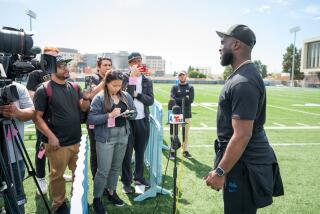It’s About Time to Quit Bashing the Coliseum’s Neighborhood
The politics of pro sports is loaded with phoniness and hype. But nothing surpasses the current smear campaign against the Los Angeles Memorial Coliseum and the neighborhood around it.
The smears are a subtext of a larger story, the effort by city officials, team owners and developers to create a “sports corridor” beginning at Dodger Stadium and extending south along Figueroa. It would include a new arena, hotels and shops around the Convention Center and a stadium for a National Football League team, either at Dodger Stadium, near the Convention Center or in a rebuilt and refurbished Coliseum.
The bottom line is that the incredibly powerful NFL does not want to play in the Coliseum, an old stadium located adjacent to USC and surrounded by working-class black and Latino neighborhoods. The league says it wants a more modern stadium. But Al Davis, the Raiders’ boss, was much more specific when, uncontradicted by the league, he dumped on the neighborhood before moving his team back to Oakland:
“One of the [other team] owners said to me, ‘I’m scared to get off the damn bus.’ Howie [Long, a Raiders star] would always make a big issue out of it, how he wouldn’t bring his wife and his kids to the game. And other guys would say, ‘I’m not bringing my wife.’ ”
That’s a laugh, coming from the man who created a culture of violence at the Coliseum, and profited from it.
*
Anyone who ever attended a Raiders game knew the real danger was from the fans inside the Coliseum rather than the residents of the surrounding neighborhoods.
Davis fielded the Hells Angels of football, a team famous for brutal cheap shots and high numbers of penalties. The Raiders built an outlaw image and attracted a ferociously loyal cadre of like-minded followers.
The NFL loved the image. Cynical hype spurred the sales of silver and black Raiders garb and other paraphernalia, making money for Davis and other owners. Not surprisingly, gangbangers were among the greatest customers. You don’t see gang members wearing the pastels of the Miami Dolphins or the red, white and blue of the Patriots.
Once inside the Coliseum gates, fans had to weave through a frightening bunch of drunks. The first rule of survival was never make eye contact. Six years ago, a Pittsburgh Steelers fan was badly beaten by Raider adherents. A few years before that, mounted cops were called into the Coliseum to break up a mob.
It took a massive police presence inside the Coliseum, paid for by the Coliseum Commission, to finally make the place safe enough for Howie Long or anyone else to take their kids. “We have a technique where the officers move toward a problem with immediate and strong force,” said Deputy Chief Mark Kroeker, who is in charge of police operations in South L.A.
Kroeker is furious about media portrayals of the Coliseum neighborhood as dangerous.
“The Coliseum area is not classified as a high-crime area by the Los Angeles Police Department,” he said. In fact, he said, “in my judgment, the Coliseum is the best policed and safest sports venue in the United States. Period. I am absolutely convinced of it.”
To illustrate his point, Kroeker offered these statistics:
A 1993 study showed that there were fewer crimes around the Coliseum on game days than near Inglewood’s Forum, home of the basketball Lakers and the hockey Kings. Another study analyzed the types of game-day crimes around the Coliseum--one or two auto break-ins and nonviolent thefts.
The Coliseum came out well in comparison with another South L.A. area, which extends from Crenshaw Boulevard through a huge low-income apartment project and up into middle-class and affluent Baldwin Hills.
In the second quarter of this year, the Crenshaw area reported 30 robberies, compared with six for the Coliseum neighborhood; 33 burglaries, as opposed to the Coliseum area’s two; 36 auto thefts, compared with the Coliseum district’s five.
Don’t get me wrong. The Coliseum area isn’t Beverly Hills or Brentwood. As I said, it’s a hard-edged working-class neighborhood, with poverty and gangs. People stop in at the no-frills but clean Benjy’s Jr. Market and Deli rather than Starbucks.
Despite the poverty, the proprietor of Benjy’s, Jimmy Park, went along with what Deputy Chief Kroeker said. “‘I’ve been here nine years,” said Park, whose store is across Vermont Avenue from the Coliseum. “If I felt threatened, could I keep my business here?”
In his office across the street from the market, Lee Jenkins, vice president of the Black Foundation, a community organization, agreed. “There’s crime,” he said. “‘But I think crime has decreased drastically.”
*
This is a side issue in the sports corridor discussion. It’s highly unlikely the NFL will put a team in the Coliseum. The league wants an ultramodern facility with luxury boxes that will fatten the owners’ bank accounts. It will probably be adjacent to Dodger Stadium or near the proposed arena at the Convention Center.
But until the decision is made, the NFL ought to come clean and say its real--and only--motive for rejecting the Coliseum is money. So far, the league has refused to do this. When I asked the NFL director of public relations, Greg Aiello, about crime, he said, “I don’t know. I don’t know enough about the area.”
Such ambiguous statements keep the crime talk alive. As a result, damage continues to be inflicted on a neighborhood on the comeback trail.
More to Read
Go beyond the scoreboard
Get the latest on L.A.'s teams in the daily Sports Report newsletter.
You may occasionally receive promotional content from the Los Angeles Times.










